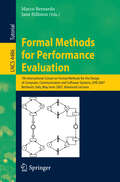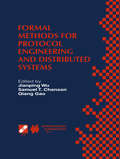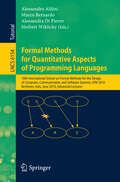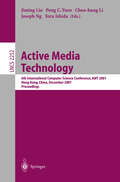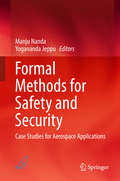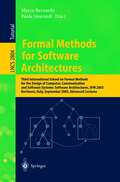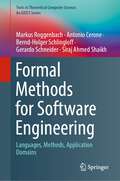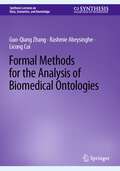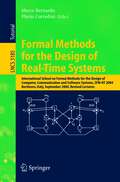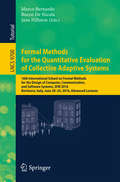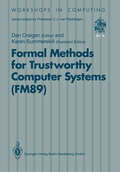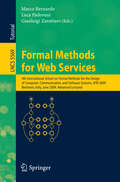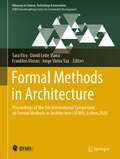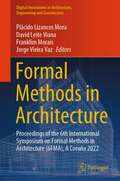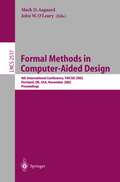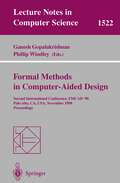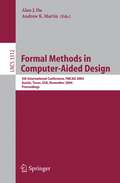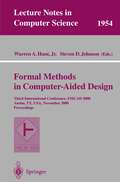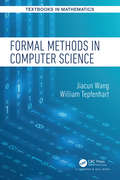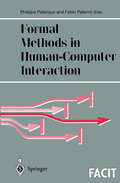- Table View
- List View
Formal Methods for Performance Evaluation: 7th International School on Formal Methods for the Design of Computer, Communication, and Software Systems, SFM 2007, Bertinoro, Italy, May 8-June 2, 2007, Advanced Lectures (Lecture Notes in Computer Science #4486)
by Marco Bernardo Jane HillstonThis book presents a set of 11 papers accompanying the lectures of leading researchers given at the 7th edition of the International School on Formal Methods for the Design of Computer, Communication and Software Systems, SFM 2007, held in Bertinoro, Italy in May/June 2007. SFM 2007 was devoted to formal techniques for performance evaluation and covered several aspects of the field.
Formal Methods for Protocol Engineering and Distributed Systems: Forte XII / PSTV XIX’99 (IFIP Advances in Information and Communication Technology #28)
by Jianping Jianping Wu Samuel T. Chanson Quiang Quiang GaoFormal Methods for Protocol Engineering and Distributed Systems addresses formal description techniques (FDTs) applicable to distributed systems and communication protocols. It aims to present the state of the art in theory, application, tools an industrialization of FDTs. Among the important features presented are: FDT-based system and protocol engineering; FDT application to distributed systems; Protocol engineeering; Practical experience and case studies. Formal Methods for Protocol Engineering and Distributed Systems contains the proceedings of the Joint International Conference on Formal Description Techniques for Distributed Systems and Communication Protocols and Protocol Specification, Testing, and Verification, which was sponsored by the International Federation for Information Processing (IFIP) and was held in Beijing, China, in October 1999. This volume is suitable as a secondary text for a graduate level course on Distributed Systems or Communications, and as a reference for researchers and industry practitioners.
Formal Methods for Quantitative Aspects of Programming Languages: 10th International School on Formal Methods for the Design of Computer, Communication and Software Systems, SFM 2010, Bertinoro, Italy, June 21, 2010, Advanced Lectures (Lecture Notes in Computer Science #6154)
by Alessandro Aldini Marco Bernardo Alessandra Di Pierro Herbert WiklickyFormal Methods for Real-Time and Probabilistic Systems: 5th International AMAST Workshop, ARTS'99, Bamberg, Germany, May 26-28, 1999, Proceedings (Lecture Notes in Computer Science #1601)
by Jost-Pieter KatoenFormal Methods for Safety and Security: Case Studies for Aerospace Applications
by Manju Nanda Yogananda JeppuThis volume is the outcome of deliberations on formal methods in aerospace. The book specially delves into the use of formal methods for verification, validation, and optimization of software in safety critical and time critical applications, such as those in aerospace engineering. The chapters in this book are authored by leading corporate and government R&D scientists. The contents of this book will be useful to researchers and professionals alike.
Formal Methods for Software Architectures: Third International School on Formal Methods for the Design of Computer, Communication and Software Systems: Software Architectures, SFM 2003, Bertinoro, Italy, September 22-27, 2003, Advanced Lectures (Lecture Notes in Computer Science #2804)
by Marco Bernardo Paola InverardiIn the past ten years or so, software architecture has emerged as a central notion in the development of complex software systems. Software architecture is now accepted in the software engineering research and development community as a manageable and meaningful abstraction of the system under development and is applied throughout the software development life cycle, from requirements analysis and validation, to design and down to code and execution level. This book presents the tutorial lectures given by leading authorities at the Third International School on Formal Methods for the Design of Computer, Communication and Software Systems, SFM 2003, held in Bertinoro, Italy, in September 2003. The book is ideally suited for advanced courses on software architecture as well as for ongoing education of software engineers using formal methods in their day-to-day professional work.
Formal Methods for Software Engineering: Languages, Methods, Application Domains (Texts in Theoretical Computer Science. An EATCS Series)
by Antonio Cerone Siraj Ahmed Shaikh Markus Roggenbach Gerardo Schneider Bernd-Holger SchlingloffSoftware programs are formal entities with precise meanings independent of their programmers, so the transition from ideas to programs necessarily involves a formalisation at some point. The first part of this graduate-level introduction to formal methods develops an understanding of what constitutes formal methods and what their place is in Software Engineering. It also introduces logics as languages to describe reasoning and the process algebra CSP as a language to represent behaviours. The second part offers specification and testing methods for formal development of software, based on the modelling languages CASL and UML. The third part takes the reader into the application domains of normative documents, human machine interfaces, and security. Use of notations and formalisms is uniform throughout the book. Topics and features: Explains foundations, and introduces specification, verification, and testing methods Explores various application domains Presents realistic and practical examples, illustrating concepts Brings together contributions from highly experienced educators and researchers Offers modelling and analysis methods for formal development of software Suitable for graduate and undergraduate courses in software engineering, this uniquely practical textbook will also be of value to students in informatics, as well as to scientists and practical engineers, who want to learn about or work more effectively with formal theories and methods. Markus Roggenbach is a Professor in the Dept. of Computer Science of Swansea University. Antonio Cerone is an Associate Professor in the Dept. of Computer Science of Nazarbayev University, Nur-Sultan. Bernd-Holger Schlingloff is a Professor in the Institut für Informatik of Humboldt-Universität zu Berlin. Gerardo Schneider is a Professor in the Dept. of Computer Science and Engineering of University of Gothenburg. Siraj Ahmed Shaikh is a Professor in the Institute for Future Transport and Cities of Coventry University.
Formal Methods for the Analysis of Biomedical Ontologies (Synthesis Lectures on Data, Semantics, and Knowledge)
by Guo-Qiang Zhang Rashmie Abeysinghe Licong CuiThe book synthesizes research on the analysis of biomedical ontologies using formal concept analysis, including through auditing, curation, and enhancement. As the evolution of biomedical ontologies almost inevitably involves manual work, formal methods are a particularly useful tool for ontological engineering and practice, particularly in uncovering unexpected "bugs" and content materials. The book first introduces simple but formalized strategies for discovering undesired and incoherent patterns in ontologies before exploring the application of formal concept analysis for semantic completeness. The book then turns to formal concept analysis, a classical approach used in the mathematical treatment of orders and lattices, as an ontological engineering principle, focusing on the structural property of ontologies with respect to its conformation to lattice or not (non-lattice). The book helpfully covers the development of more efficient algorithms for non-lattice detection and extraction required by exhaustive lattice/non-lattice analysis. The book goes on to highlight the power and utility of uncovering non-lattice structure for debugging ontologies and describes methods that leverage the linguistic information in concept names (labels) for ontological analysis. It also addresses visualization and performance evaluation issues before closing with an overview and forward-looking perspectives on the field. This book is intended for graduate students and researchers interested in biomedical ontologies and their applications. It can be a useful supplement for courses on knowledge representation and engineering and also provide readers with a reference for related scientific publications and literature to assist in identifying potential research topics. All mathematical concepts and notations used in this book can be found in standard discrete mathematics textbooks, and the appendix at the end of the book provides a list of key ontological resources, as well as annotated non-lattice and lattice examples that were discovered using the authors' methods, demonstrating how "bugs are fixed" by converting non-lattices to lattices with minimal edit changes.
Formal Methods for the Design of Real-Time Systems: International School on Formal Methods for the Design of Computer, Communication, and Software Systems, SFM-RT 2004, Bertinoro, Italy, September 13-18, 2004, Revised Lectures (Lecture Notes in Computer Science #3185)
by Marco Bernardo Flavio CorradiniFormal Methods for the Quantitative Evaluation of Collective Adaptive Systems: 16th International School on Formal Methods for the Design of Computer, Communication, and Software Systems, SFM 2016, Bertinoro, Italy, June 20-24, 2016, Advanced Lectures (Lecture Notes in Computer Science #9700)
by Marco Bernardo Rocco De Nicola Jane HillstonThis book presents 8 tutorial lectures given by leading researchers at the 16th edition of the International School on Formal Methods for the Design of Computer, Communication and Software Systems, SFM 2016, held in Bertinoro, Italy, in June 2016. SFM 2016 was devoted to the Quantitative Evaluation of Collective Adaptive Systems and covered topics such as self-organization in distributed systems, scalable quantitative analysis, spatio-temporal models, and aggregate programming.
Formal Methods for Trustworthy Computer Systems: Report from FM89: A Workshop on the Assessment of Formal Methods for Trustworthy Computer Systems 23–27 July 1989, Halifax, Canada (Workshops in Computing)
by Karen SummerskillThe 1989 Workshop on the Assessment of Formal Methods for Trustworthy Com puter Systems (FM89} was an invitational workshop that brought together repre sentatives from the research, commercial and governmental spheres of Canada, the United Kingdom, and the United States. The workshop was held in Halifax, Nova Scotia, Canada, from July 23 through July 27, 1989. This document reports the activities, observations, recommendations and conclusions resulting. from FM89. 1. 1 Purpose of Workshop The primary purpose for holding FM89 was to assess the role of formal methods in the development and fielding of trustworthy critical systems. The need for this assessment was predicated upon four observations: 1. Critical systems are increasingly being controlled by computer systems; 2. Existing techniques for developing, assuring and certifying computer-based critical systems are inadequate; 3. Formal methods have the potential for playing the same role in the devel opment of computer-based systems as applied mathematics does for other engineering disciplines; and 4. Formal methods have had limited impact on the development of comput- based systems and supporting technologies. · The goal of the workshop was to complete the following tasks: 1. Assess the problems retarding the development of trustworthy critical systems; 2. Determine the (potential) impact of applying formal methods techniques to the development of trustworthy critical systems; 3. Determine the research and development required to facilitate a broader ap plication of formal methods techniques; 4.
Formal Methods for Web Services: 9th International School on Formal Methods for the Design of Computer, Communication and Software Systems, SFM 2009, Bertinoro, Italy, June 1-6, 2009, Advanced Lectures (Lecture Notes in Computer Science #5569)
by Marco Bernardo Luca Padovani Gianluigi ZavattaroFormal Methods in Architecture: Proceedings of the 5th International Symposium on Formal Methods in Architecture (5FMA), Lisbon 2020 (Advances in Science, Technology & Innovation)
by Sara Eloy David Leite Viana Franklim Morais Jorge Vieira VazThis edited book gathers research studies presented at the 5th International Symposium on Formal Methods in Architecture (5FMA), Lisbon 2020. Studies focus on the use of methodologies, especially those that have witnessed recent developments, that stem from the mathematical and computer sciences and are developed in a collaborative way with architecture and related fields. This book constitutes a contribution to the debate and to the introduction of new methodologies and tools in the mentioned fields that derive from the application of formal methods in the creation of new explicit languages for problem-solving in architecture and urbanism. It adds valuable insight into the development of new practices solving identified societal problems and promoting the digital transformation of institutions in the mentioned fields. The primary audience of this book will be from the fields of architecture, urban planning, civil engineering, AEC, landscape design, computer sciences and mathematics, both academicians and professionals.
Formal Methods in Architecture: Proceedings of the 6th International Symposium on Formal Methods in Architecture (6FMA), A Coruña 2022 (Digital Innovations in Architecture, Engineering and Construction)
by Plácido Lizancos Mora David Leite Viana Franklim Morais Jorge Vieira VazThis book comprises the select proceedings of the 6th International Symposium on Formal Methods in Architecture (6FMA), A Coruña 2022. The contents focus on the use of methodologies, especially those that have witnessed recent developments stemming from mathematical and computer sciences and are developed in a collaborative way with architecture and related fields. This book constitutes a contribution to the debate and to the introduction of new methodologies and tools in the mentioned fields that derive from the application of formal methods in the creation of new explicit languages for problem-solving in architecture and urbanism. Some of the themes in the book are CAD and BIM, mixed realities, photogrammetry and 3D scan, architectural design automation, urban and building performance analysis, SCAVA-space configuration, accessibility and visibility analysis. This book proves a valuable resource for those in academia and industry.
Formal Methods in Computer-Aided Design: 4th International Conference, FMCAD 2002, Portland, OR, USA, November 6-8, 2002, Proceedings (Lecture Notes in Computer Science #2517)
by Mark D. Aagaard John W. O'LearyThis volume contains the proceedings of the Fourth Biennial Conference on F- mal Methods in Computer-Aided Design (FMCAD). The conference is devoted to the use of mathematical methods for the analysis of digital hardware c- cuits and systems. The workreported in this bookdescribes the use of formal mathematics and associated tools to design and verify digital hardware systems. Functional veri?cation has become one of the principal costs in a modern computer design e?ort. FMCAD provides a venue for academic and industrial researchers and practitioners to share their ideas and experiences of using - screte mathematical modeling and veri?cation. Over the past 20 years, this area has grown from just a few academic researchers to a vibrant worldwide com- nity of people from both academia and industry. This volume includes 23 papers selected from the 47 submitted papers, each of which was reviewed by at least three program committee members. The history of FMCAD dates backto 1984, when the earliest meetings on this topic occurred as part of IFIP WG10.2.
Formal Methods in Computer-Aided Design: Second International Conference, FMCAD '98, Palo Alto, CA, USA, November 4-6, 1998, Proceedings (Lecture Notes in Computer Science #1522)
by Ganesh Gopalakrishnan Phillip WindleyFormal Methods in Computer-Aided Design: 5th International Conference, FMCAD 2004, Austin, Texas, USA, November 15-17, 2004, Proceedings (Lecture Notes in Computer Science #3312)
by Alan J. Hu Andrew K. MartinFormal Methods in Computer-Aided Design: Third International Conference, FMCAD 2000 Austin, TX, USA, November 1-3, 2000 Proceedings (Lecture Notes in Computer Science #1954)
by Warren A. Jr. Hunt Steven D. JohnsonThe biannual Formal Methods in Computer Aided Design conference (FMCAD 2000)is the third in a series of conferences under that title devoted to the use of discrete mathematical methods for the analysis of computer hardware and so- ware. The work reported in this book describes the use of modeling languages and their associated automated analysis tools to specify and verify computing systems. Functional veric ation has become one of the principal costs in a modern computer design e ort. In addition,verica tion of circuit models, timing,power, etc., requires even more eo rt. FMCAD provides a venue for academic and - dustrial researchers and practitioners to share their ideas and experiences of using discrete mathematical modeling and veric ation. It is noted with interest by the conference chairmen how this area has grown from just a few people 15 years ago to a vibrant area of research, development, and deployment. It is clear that these methods are helping reduce the cost of designing computing systems. As an example of this potential cost reduction, we have invited David Russino of Advanced Micro Devices, Inc. to describe his veric ation of ?oating-point - gorithms being used in AMD microprocessors. The program includes 30 regular presentations selected from 63 submitted papers.
Formal Methods in Computer Science
by Jiacun WangThis textbook gives students a comprehensive introduction to formal methods and their application in software and hardware specification and verification. It has three parts: The first part introduces some fundamentals in formal methods, including set theory, functions, finite state machines, and regular expressions. The second part focuses on logi
Formal Methods in Computer Science (Textbooks In Mathematics Ser.)
by Jiacun WangThis textbook gives students a comprehensive introduction to formal methods and their application in software and hardware specification and verification. It has three parts: The first part introduces some fundamentals in formal methods, including set theory, functions, finite state machines, and regular expressions. The second part focuses on logi
Formal Methods in Databases and Software Engineering: Proceedings of the Workshop on Formal Methods in Databases and Software Engineering, Montreal, Canada, 15–16 May 1992 (Workshops in Computing)
by V. S. Alagar Laks V. S. Lakshmanan F. SadriLogic and object-orientation have come to be recognized as being among the most powerful paradigms for modeling information systems. The term "information systems" is used here in a very general context to denote database systems, software development systems, knowledge base systems, proof support systems, distributed systems and reactive systems. One of the most vigorously researched topics common to all information systems is "formal modeling". An elegant high-level abstraction applicable to both application domain and system domain concepts will always lead to a system design from "outside in"; that is, the aggregation of ideas is around real-life objects about which the system is to be designed. Formal methods \yhen applied with this view in mind, especially during early stages of system development, can lead to a formal reasoning on the intended properties, thus revealing system flaws that might otherwise be discovered much later. Logic in different styles and semantics is being used to model databases and their transactions; it is also used to specify concurrent, distributed, real-time, and reactive systems. ,The notion of "object" is central to the modeling of object oriented databases, as well as object-oriented design and programs in software engineering. Both database and software engineering communities have undoubtedly made important contributions to formalisms based on logic and objects. It is worthwhile bringing together the ideas developed by the two communities in isolation, and focusing on integrating their common strengths.
Formal Methods in Human-Computer Interaction (Formal Approaches to Computing and Information Technology (FACIT))
by Philippe Palanque Fabio PaternòFormal methods have already been shown to improve the development process and quality assurance in system design and implementation. This volume examines whether these benefits also apply to the field of human-computer interface design and implementation, and whether formal methods can offer useful support in usability evaluation and obtaining more reliable implementations of user requirements. Its main aim is to compare the different approaches and examine which particular type of implementation and problem each one is best suited to. To enable the reader to compare and contrast the approaches as easily as possible, each one is applied to the same case study: the specification of an ideal Netscape-like web browser and html page server. The resulting volume will provide invaluable reading for final year undergraduate and postgraduate courses on user interfaces, user interface design, and applications of formal methods.
Formal Methods in Macro-Biology: First International Conference, FMMB 2014, Noumea, New Caledonia, September 22-14, 2014, Proceedings (Lecture Notes in Computer Science #8738)
by François Fages Carla PiazzaThis book constitutes the refereed proceedings of the First International Conference on Formal Methods in Macro-Biology, FMMB 2014, held in Nouméa, New Caledonia, in September 2014.The 7 revised full and 3 short papers presented together with 7 invited presentations were carefully reviewed and selected from 17 submissions. The scientific program consists of papers on a wide variety of topics, including ecological systems, medical applications, logical frameworks, and discrete continuous and hybrid models for the analysis of biological systems at macroscopic levels.
Formal Methods in Outer Space: Essays Dedicated to Klaus Havelund on the Occasion of His 65th Birthday (Lecture Notes in Computer Science #13065)
by Ezio Bartocci Yliès Falcone Martin LeuckerThis Festschrift, dedicated to Klaus Havelund on the occasion of his 65th birthday, celebrated in 2021 due to the COVID-19 pandemic, contains papers written by many of his closest friends and collaborators.After work as a software programmer in various Danish companies, Klaus has held research positions at various institutes, including the Danish Datamatics Center, the Ecole Polytechnique, LIP 6 lab in Paris, Aalborg University, and NASA Ames. Since 2006 he has been working in NASA’s Jet Propulsion Laboratory (JPL), the federally funded center managed by Caltech whose primary function is to construct and operate planetary robotic spacecraft. His professional awards include the Turning Goals Into Reality engineering innovation award, the Outstanding Technology Development award, and the JPL Mariner, Ranger, Voyager, and Magellan awards. Klaus has provided constant and generous service to the formal methods community by organizing, participating in, and chairing numerous committees. His academic awards include the 2020 SIGSOFT Impact Paper Award, the RV 2018 Test of Time award, and the ASE 2014 and ASE 2016 Most Influential Paper awards. His research activities have generated more than 100 publications with more than 100 collaborators, cited over 12,000 times. The book title reflects Klaus’s main research and engineering focus throughout his career: formal methods, often applied at NASA. The contributions, which went through a peer-review process, cover a wide spectrum of the topics related to his scientific interests, including programming language design, static analysis, runtime verification, dynamic assurance, and automata learning.
Formal Methods in Software and Systems Modeling: Essays Dedicated to Hartmut Ehrig on the Occasion of His 60th Birthday (Lecture Notes in Computer Science #3393)
by Hans-Jörg Kreowski Ugo Montanari Fernando Orejas Grzegorz Rozenberg Gabriele TaentzerBy presenting state-of-the-art research results on various aspects of formal and visual modeling of software and systems, this book commemorates the 60th birthday of Hartmut Ehrig. The 24 invited reviewed papers are written by students and collaborators of Hartmut Ehrig who are established researchers in their fields. Reflecting the scientific interest and work of Hartmut Ehrig, the papers fall into three main parts on graph transformation, algebraic specification and logic, and formal and visual modeling.
